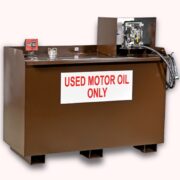Choosing the right tank design is essential for efficient and secure oil storage. Among the available options, vertical and horizontal oil storage tanks stand out as popular choices due to their versatility and effectiveness. By understanding their differences and advantages, you can select the oil storage solutions that best fit your needs. Learn more about the benefits and features of these tanks as we explore what makes each design suitable for various applications.
The Basics of Vertical Oil Storage Tanks
Vertical oil storage tanks are designed to stand upright, a feature that optimizes space usage and enhances storage capacity. These tanks are ideal for locations where floor space is limited.
Advantages of Vertical Tanks
- Space-Saving Design – Vertical tanks are compact in terms of ground area but maintain a high storage capacity by utilizing height. This makes them a smart choice for facilities with spatial constraints.
- Efficient Maintenance – Built-in inspection ports and gauges commonly found on vertical tanks make it easier to monitor contents and ensure proper maintenance. Regular checks can extend the lifespan of the tank and protect the oil quality.
- Reduced Sediment Accumulation – The upright design helps minimize sediment buildup at the tank’s base, leading to cleaner oil storage and less waste during usage or transfer.
Despite these advantages, vertical tanks often require a solid and level foundation to maintain stability, along with adequate height clearance for installation.
Exploring Horizontal Oil Storage Tanks
Horizontal oil storage tanks are structured to lay flat on their sides, offering a low-profile build suitable for diverse environments. These tanks are known for their stability and adaptability.
Advantages of Horizontal Tanks
- Enhanced Stability – The horizontal layout ensures a low center of gravity, making these tanks easier to stabilize on uneven or outdoor surfaces.
- Simplified Installation – Horizontal tanks demand fewer support structures for setup, allowing for quicker and less complicated installation processes.
- Accessibility Benefits – Positioned closer to the ground, horizontal tanks are convenient for workers to refill, drain, or inspect without requiring additional tools or platforms.
On the downside, horizontal tanks consume more floor space, which may not be ideal in areas with limited room.
Choosing the Best Tank for Your Needs
The decision between vertical and horizontal tanks depends on factors like available space, usage priorities, and maintenance needs. Vertical tanks are a practical choice for organizations that prioritize space efficiency while minimizing oil waste. Conversely, horizontal tanks are more suitable for operations requiring greater accessibility and stability.
Regardless of the tank design, implementing best practices for storing and handling oil drain equipment is crucial. Secure handling practices help avoid contamination, reduce heavy wear, and extend equipment life. Proper care ensures smoother and safer operations over time.
Final Considerations
Both tank designs serve their purpose effectively, but the optimal selection depends on your specific needs. Carefully assess factors like space availability, operational convenience, and maintenance requirements before making a decision. With the right oil storage solutions that align with your goals, you can improve storage efficiency and maintain the value of your reserves.













